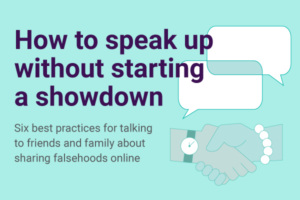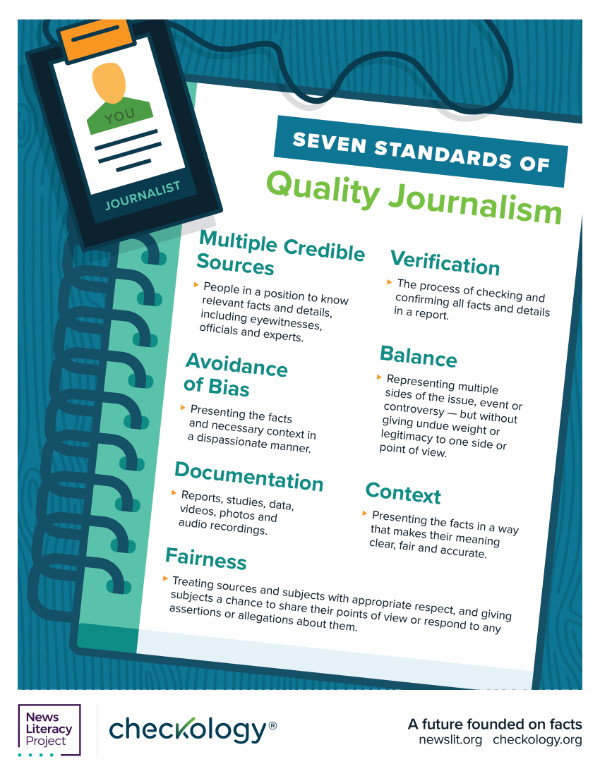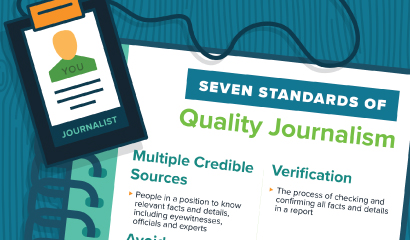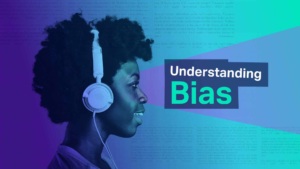In brief: News media bias
People across the political spectrum often feel that “the media” is biased against their beliefs and values. But what counts as bias in news? And why do so few people feel that news coverage is slanted in their favor?
This infographic provides six tips to help you think clearly about this nuanced and important topic:
- Differentiate news from opinion: News reports — also called “straight news” or “hard news” — should be as free of bias as possible. But remember that opinion columns, editorials and op-eds are not produced to be impartial. They’re supposed to express an opinion.
- Think about bias as a spectrum: It’s helpful to think about bias in news as a spectrum (more or less biased) rather than a binary (biased and unbiased).
- Ask yourself: Compared with what? When you encounter allegations of bias in news, keep these questions in mind: Biased compared with what? Can I point to an example of information that is fairer, more accurate and more impartial?
- Recognize your own biases: Our own preconceptions can cause us to misperceive elements of news coverage, make assumptions about the motivations of journalists, or diligently search for ways to dismiss coverage as “biased” if it challenges our beliefs.
- Be wary of media bias charts and rating: Bias charts and rating systems seem to provide an easy way to assess bias in news, but they often contain startling shortcomings.
- Think about bias in terms of types and forms: Break through the hyperbole and political rhetoric around the issue of bias by testing your initial perceptions. What type of bias do you think you’re seeing? And what form do you see it taking in coverage?
News Goggles: Emilie Munson, Times Union
It’s easy to feel overwhelmed by news coverage during an election season. With so many sources competing for attention, how can we know what to trust? Professional journalism standards are one important sign of credibility. Reputable news organizations aspire to ethical guidelines and standards, including fairness, accuracy and independence.
This week, we talk to data reporter Emilie Munson of the Times Union, a local news organization based in Albany, New York, with a coverage area that includes the state’s Capital Region and Hudson Valley. Munson sheds light on the Times Union’s decision to publish a guide explaining how the news organization covers elections and politics — and the role of journalism standards in its news decisions. We also discuss the Times Union’s strict policies on the use of anonymous or unnamed sources. Grab your news goggles!
Note: Look for this newsletter feature the first Monday of the month. You can explore previous News Goggles videos, annotations and activities in NLP’s Resource Library under “Classroom Activities.”
Resources:
- “Practicing Quality Journalism” and “Understanding Bias” (NLP’s Checkology® virtual classroom).
- Infographic: “Is it legit? Five steps for vetting a news source” (NLP’s Resource Library).
Dig deeper: Use this viewing guide for the featured News Goggles video as students consider the role of journalism standards in covering elections and politics.
News Goggles annotations and activities provide news literacy takeaways on timely topics. These resources feature examples of actual news coverage, including full news reports, headlines, breaking news alerts or excerpts.
This video originally appeared in the Nov. 7, 2022, issue of The Sift® newsletter for educators, which explores timely examples of misinformation, addresses journalism and press freedom topics and examines social media trends and issues. Read archives of the newsletter and subscribe here. Stock music in this video was provided by SoundKit from Pond5.
Have feedback about this resource? Or an idea for a future News Goggles? Please share it with us at [email protected].
News Goggles: Covering a newsworthy trial
News Goggles annotations and activities offer news literacy takeaways on timely topics. These resources feature examples of actual news coverage, including full news reports, headlines, breaking news alerts or excerpts.
This News Goggles resource originally appeared in a previous issue of The Sift newsletter for educators, which explores timely examples of misinformation, addresses journalism and press freedom topics and examines social media trends and issues. Read archives of the newsletter and subscribe here.
As high-profile court cases unfold, journalists monitor and sort through hours of proceedings in real time. News organizations work to spotlight and explain standout moments for their audiences, who may be aware of a trial but aren’t following it gavel-to-gavel.
In this edition of News Goggles, let’s look at the trial of Derek Chauvin, a former Minneapolis police officer charged in the death of George Floyd. In particular, let’s compare how local, national and international news organizations handled the April 5, 2021, testimony of Medaria Arradondo, the Minneapolis police chief.
Newsrooms may use a narrow or wider lens to frame their coverage, depending on their audience. For example, an international audience may be less familiar with the case and need a broader view, while local audiences may be interested in more detailed coverage. What parts of the trial did different newsrooms feature? Which comments from the police chief did they choose to quote? Grab your news goggles!
★ Featured News Goggles resource: These classroom-ready slides offer annotations, discussion questions and a teaching idea related to this topic.
Related:
- “The trial of Derek Chauvin, and the debate about cameras in court” (Jon Allsop, Columbia Journalism Review).
- “How A Minnesota Paper Is Covering The Chauvin Trial From The Black Perspective” (Ari Shapiro, NPR).
- “For Black journalists, working Chauvin trial drains emotions” (David Bauder, The Associated Press).
Discuss: Have you followed news coverage of Chauvin’s trial? If so, how? How do news organizations tailor coverage for their audiences? Whose coverage of the trial do you like best? Why?
Idea: Pick two news reports related to the police chief’s testimony. Using a Venn diagram, take notes on similarities and differences, focusing on how the stories begin, quotes and other details. Share your findings with the class.
Have feedback about this resource? Or an idea for a future News Goggles? Please share it with us at [email protected]. You can also use this guide for a full list of News Goggles from the 2020-21 school year for easy reference.
News Goggles: Tracking developing stories
News Goggles annotations and activities offer news literacy takeaways on timely topics. These resources feature examples of actual news coverage, including full news reports, headlines, breaking news alerts or excerpts.
This News Goggles resource originally appeared in a previous issue of The Sift newsletter for educators, which explores timely examples of misinformation, addresses journalism and press freedom topics and examines social media trends and issues. Read archives of the newsletter and subscribe here.
As the Atlanta-area deadly spa shootings in March 2021 showed, reliable information can be scarce and change rapidly when major stories first break. How do journalists handle newsgathering when stories are still developing? How is this fluid situation reflected in news reports?
News organizations have to weigh which sources are credible and work to verify information as it evolves — all under immediate deadline pressure. Sometimes, details may turn out to be incorrect, or new information emerges that makes the story more accurate and provides important additional context. (See “Shooting coverage debates” for more details on how this particular story was covered.)
In this edition of News Goggles, let’s examine how some news organizations label updates and show transparency in their newsgathering on developing stories. Grab your news goggles. Let’s go!
★ Featured News Goggles resource: These classroom-ready slides offer annotations, discussion questions and a teaching idea related to this topic.
Discuss: If news organizations report information from an official source that later turns out to be incorrect, how should they handle this? Why does misinformation often flourish during breaking news events? How did you learn about the shootings and follow news updates? How did you know whether the information was credible? Did you see any rumors or false information about the shootings?
Idea: Have students review coverage of these shootings. Are there labels for updates? Are there links to previous or related news reports? Is there a dateline (the name of a city in all capital letters, indicating an on-the-ground reporting presence)? Are there any signs that this story is developing and will be updated?
Resources:
- “Practicing Quality Journalism” (NLP’s Checkology virtual classroom).
- “The Breaking News Consumer’s Handbook” (WNYC).
Have feedback about this resource? Or an idea for a future News Goggles? Please share it with us at [email protected]. You can also use this guide for a full list of News Goggles from the 2020-21 school year for easy reference.
How to speak up without starting a showdown
 Misinformation is always problematic, but when it appears alongside pet photos and family updates on social media, it can be especially frustrating and unwelcome. It’s one thing if a stranger spreads falsehoods online. But what should we do when we see misinformation shared by family and friends?
Misinformation is always problematic, but when it appears alongside pet photos and family updates on social media, it can be especially frustrating and unwelcome. It’s one thing if a stranger spreads falsehoods online. But what should we do when we see misinformation shared by family and friends?
Stepping into the role of fact-checker when it comes to loved ones can be tricky and stir strong emotions, so it’s worth preparing for — especially as more falsehoods seep across social media and into family and friend group chats.
While every scenario is different, following some general best practices can help keep the conversation civil and make the interaction worthwhile. Use these six tips — with some helpful phrases for getting started — as a guide on how to speak up without starting a showdown. It may not be easy, but talking to loved ones about false or misleading content can help them think twice about what to share in the future.
News Goggles: Mobile news alerts on President Donald Trump’s election outcome claims
News Goggles annotations and activities offer news literacy takeaways on timely topics. These resources feature examples of actual news coverage, including full news reports, headlines, breaking news alerts or excerpts.
This News Goggles resource originally appeared in a previous issue of The Sift newsletter for educators, which explores timely examples of misinformation, addresses journalism and press freedom topics and examines social media trends and issues. Read archives of the newsletter and subscribe here.
President Donald Trump spoke during the early morning hours of Nov. 4, 2020, following Election Day, alleging fraud and claiming victory even as results in several states were still uncertain. News organizations that sent mobile news alerts about Trump’s remarks varied in how they handled the claims. Let’s take a closer look at word choice and framing as we consider how these factors shaped some news organizations’ approach to reporting on the president’s remarks in their efforts to be fair, accurate and fast. Grab your news goggles, and let’s go!
★ Featured News Goggles resources: These classroom-ready slides offer annotations and questions on this topic.
Related:
- “MSNBC, major networks interrupt Trump’s falsehood-laden speech to fact-check; Fox, CNN carry in full” (Bill Keveney, USA Today).
- “‘Without evidence’ Is A New Catchphrase at NPR” (Kelly McBride, NPR).
- “How newspaper front pages treated an Election Day with no clear winner” (Marisa Iati, The Washington Post).
Discuss: What thoughts do you have about how these five news organizations worded their alerts? Which alerts did you think were the best? Why? Which, if any, were problematic? Why? Did any of the word choices show potential bias? If so, how could those alerts have been more accurate?
Idea: Have students review the Nov. 4, 2020, post-Election Day front page of The Atlanta Journal-Constitution — which featured a headline criticized as a “both sides” approach that spread inaccurate information — along with other front pages collected by Poynter. Do students agree with how the Journal-Constitution handled the election uncertainty? Why or why not? Do they agree or disagree with the criticism aimed at the headline? How does it compare with the other headlines? Which headline do students think is best? If the class had to write a headline for this story, what would it be?
Have feedback about this resource? Or an idea for a future News Goggles? Please share it with us at [email protected]. You can also use this guide for a full list of News Goggles from the 2020-21 school year for easy reference.
News Goggles: Race in headlines
News Goggles annotations and activities offer news literacy takeaways on timely topics. These resources feature examples of actual news coverage, including full news reports, headlines, breaking news alerts or excerpts.
This News Goggles resource originally appeared in a previous issue of The Sift newsletter for educators, which explores timely examples of misinformation, addresses journalism and press freedom topics and examines social media trends and issues. Read archives of the newsletter and subscribe here.
On Oct. 26, 2020, Philadelphia police fatally shot Walter Wallace Jr., a 27-year-old Black man who was holding a knife. Wallace’s death prompted protests that at times turned violent. News coverage of the fatal shooting called new attention to the ongoing debate in journalism over when to include race as a relevant detail, especially in headlines. In this edition of News Goggles, we’re going to compare three headlines on the incident and examine different approaches by news organizations to reporting on the role of race in this story.
★ Featured News Goggles resource: These classroom-ready slides offer annotations and questions on this topic.
Discuss: Which of the three headlines do students think is the best? Why? If the class had to write a headline for this news event, what would it be? Would it include any references to race, either in reference to Wallace or the officers?
Note: Many news organizations follow the editing rules and language suggestions outlined in The Associated Press Stylebook. It includes entries about race-related coverage and offers this guidance: “Consider carefully when deciding whether to identify people by race. Often, it is an irrelevant factor and drawing unnecessary attention to someone’s race or ethnicity can be interpreted as bigotry. There are, however, occasions when race is pertinent.” In June 2020, AP updated its style to capitalize Black “when referring to people in a racial, ethnic or cultural context.”
Idea: Have students read this piece from AP, which explains the organization’s decision to capitalize Black, among other races and ethnicities, but not “white.” Do students agree or disagree with AP’s approach? Why? Consider sharing students’ feedback with AP here.
Have feedback about this resource? Or an idea for a future News Goggles? Please share it with us at [email protected]. You can also use this guide for a full list of News Goggles from the 2020-21 school year for easy reference.
News Goggles: Breaking news alerts on Breonna Taylor case
News Goggles annotations and activities offer news literacy takeaways on timely topics. These resources feature examples of actual news coverage, including full news reports, headlines, breaking news alerts or excerpts.
This News Goggles resource originally appeared in a previous issue of The Sift newsletter for educators, which explores timely examples of misinformation, addresses journalism and press freedom topics and examines social media trends and issues. Read archives of the newsletter and subscribe here.
News organizations race to relay information to audiences as quickly as possible when major stories break. One way they do this is by sending breaking news alerts to people who have their apps installed on their mobile devices. In this edition of News Goggles, we’ve selected a sample of alerts sent on Sept. 23, 2020, following the decision by a grand jury not to charge any officers in the fatal shooting of Breonna Taylor in Louisville, Kentucky — and to charge one of them in connection with shooting into a neighboring apartment.
Let’s use our news goggles to examine these alerts and consider what factors shaped their wording in journalists’ efforts to be fair, accurate and fast.
★ Featured News Goggles resources: Download our full annotations in Microsoft Word or as a PDF. Also, these classroom-ready slides pinpoint the big takeaways for a discussion with students.
Related: “How the media handled Wednesday’s Breonna Taylor ruling” (Tom Jones, Poynter).
Idea: Have students compare and contrast headlines of Breonna Taylor coverage from a selection of Sept. 24 front pages published across the United States. What details do some include, but not others? Which headline does the class think is the best? Why? If the class had to write a headline for this story, what would it be?
Have feedback about this resource? Or an idea for a future News Goggles? Please share it with us at [email protected]. You can also use this guide for a full list of News Goggles from the 2020-21 school year for easy reference.
Seven standards of quality journalism

The standards and practices of quality journalism are complex, numerous and dynamic, and are implemented differently by different journalists and different news organizations under different circumstances on different pieces of journalism. See a trend here? Practicing journalism is complicated and nuanced. Still, the general purpose behind the standards is the same: to produce the most accurate, fair and useful information possible.
Some journalism standards are obligatory (such as the prohibition against making things up) and quantifiable (such as newsroom policies about the use of anonymous sources), while others are aspirational (such as the attempt to eliminate bias and to be as fair and accurate as possible) and require judgment and discussion to apply (such as assessing newsworthiness, evaluating sources and determining fairness).
 In almost all cases at major news organizations, these standards are subject to constant reconsideration and revision — whether to prevent the recurrence of an error or to adapt to new tools and methods of gathering and reporting information (for example, using social media to locate sources, or livestreaming breaking news events).
In almost all cases at major news organizations, these standards are subject to constant reconsideration and revision — whether to prevent the recurrence of an error or to adapt to new tools and methods of gathering and reporting information (for example, using social media to locate sources, or livestreaming breaking news events).
By introducing students to the major standards of quality journalism, and helping them understand their nature and rationale, you’re providing them with conceptual and analytical tools that they can use to evaluate the credibility of the information they encounter daily and, in some cases, to critically respond to it. This knowledge can also activate a wide variety of high-level news literacy discussions in your classroom and beyond.
The seven primary standards of quality journalism and their descriptions are included in the poster linked below. This poster is adapted from a highly interactive, immersive learning experience in our Checkology® virtual classroom in which students are placed in the role of a rookie reporter on the scene of a breaking news event and learn the standards of quality journalism by “covering” the story. They are guided by their editor and a veteran reporter back in the newsroom throughout the process, and can use their virtual notebooks to see their progress in following the standards. At the end of the lesson, they build the story, selecting the most appropriate headline, lead, image and more. Use this poster with the Checkology lesson “Practicing the Standards of Quality Journalism” or on its own.
Five types of bias
Bias is one of the most controversial and important subjects in news literacy. People frequently perceive bias in news coverage, and accusations of bias are common in a wide variety of discussions and contexts. However, people generally perceive bias through the lens of their own perspectives, values and beliefs, especially if they have a strong opinion about the topic being reported on. This can cause people to engage in confirmation bias — the tendency to quickly embrace information that affirms their perspectives and beliefs and to unfairly dismiss or criticize information that complicates or contradicts them.
Because biases are baked into how we see and understand the world, people often fail to consider them when seeking or evaluating information. People also tend to only perceive bias in reporting that they consider to be against their beliefs or opinions. News coverage that is biased toward someone’s beliefs or opinions would likely just feel “right” to that person, which may help explain the popularity of openly partisan news sources.
 Because everyone has innate biases (based on their life experiences, or what they are told by their family, their friends and their teachers, or other factors), determining what constitutes bias in news coverage is extremely challenging. In fact, it’s not uncommon to see a single news report attracting conflicting accusations of bias — about its headline or an accompanying photo; about its placement in a news broadcast, in a newspaper or on a website; or about how much (or how little) coverage is devoted to its topic.
Because everyone has innate biases (based on their life experiences, or what they are told by their family, their friends and their teachers, or other factors), determining what constitutes bias in news coverage is extremely challenging. In fact, it’s not uncommon to see a single news report attracting conflicting accusations of bias — about its headline or an accompanying photo; about its placement in a news broadcast, in a newspaper or on a website; or about how much (or how little) coverage is devoted to its topic.
Finally, many conversations about bias lack specificity and nuance — in part because such discussions can become emotional, and in part because many people lack the conceptual tool set to evaluate bias and underestimate its complexity. For example, not only do people frequently forget that their own biases influence their perceptions of news coverage, they also often believe that most bias in news is overt (rather than perceived and debatable) and intentional (rather than incidental). Further, it is easy to treat the perception of bias as the end, rather than the beginning, of the process of evaluating news coverage.
But asking the following critical questions can help students fully assess the degree of impartiality or bias in a given piece of news: Could this report have been fairer? Reported more dispassionately? How? What other images or sources were available when it was published or broadcast? Was it one report in a series about a particular subject, or does it stand alone? How does it compare with other reporting from the same outlet? From other outlets?
The poster linked below introduces students to the following five types of possible bias in straight news coverage:
- Partisan bias
- Demographic bias
- Corporate bias
- “Big story” bias
- Neutrality bias
This poster is adapted from the “Understanding Bias” lesson in our Checkology® virtual classroom. Use it with that lesson or on its own.